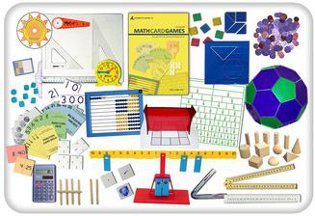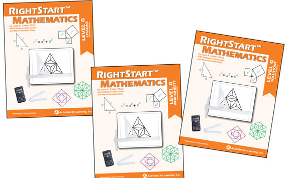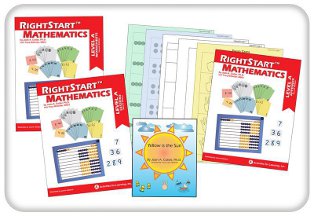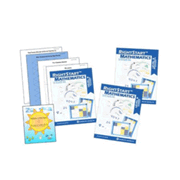RightStart™ Mathematics is an intriguing program for kindergarten through junior high. It is difficult to convey within this review the thoroughness with which concepts are taught using multi-sensory learning approaches. The author, Dr. Joan Cotter, integrates concepts more than you find in most programs, and her development of conceptual understanding is outstanding. Her goal is to lay a much stronger foundation in mathematical thinking and understanding, and I think she accomplishes this very well.
RightStart Levels A through F are considered the elementary grade program. RightStart Levels G and H target students in grades six through eight. (These last two courses share a common set of manipulatives, and I review them separately after Levels A through F.)
While first editions of Levels A through E are still available, Levels A through F are now available as RightStart second editions, referred to by the publisher as RS2. I recommend the second editions for most situations since they are more user-friendly than the first editions. The scope and sequence, as well as the presentation, have been adjusted to reflect new research and discoveries about how children learn and to better align with the more advanced scope and sequence of newer math programs. This is particularly evident in Level A where the first edition has 77 lessons while the second edition has 132. The additional lessons address topics such as subtraction and fractions. Second edition courses A through H are also available in eBook versions accessed on the Kitabook platform.
Free support for RS2 is available in the form of Weekly Overview Video Support for Levels A through F. Each video provides parents with an explanation of one week worth of the program.
The scope and sequence of RightStart Mathematics is a bit different than other programs, and children should move through it at their own pace rather than treating each book as equivalent to a particular grade level. Because it covers so much and even teaches some concepts typically taught to older students, you might take longer than one school year to complete a level. The scope and sequence is very advanced in some areas, so you might find that your child needs to work in a lower level book. Remedial students should definitely start at a lower level. A free placement test is available on the publisher's website. I think that a child completing Level H in junior high will be functioning at a level equivalent to or higher than that of most other programs for the same level.
The second edition courses build in review lessons at the beginning of each course that will familiarize those new to the program with its unique methodology. (Math Set Bridges remain available for those using a first edition course who are moving into an RS2 course. See the publisher's website for information if you need one of these.)
For each level, you will need both the book bundle plus the set of manipulatives. Each book bundle has a lessons book and a separate worksheet book (either print or digital). There is significantly less worksheet activity compared to most programs. Much of the practice and drill takes place through learning activities and games. Because of this, RightStart should work especially well for students who don’t like to do a lot of writing.
Levels A through F use the same set of manipulatives called the RightStart™ Math Set. The basic manipulative set includes the AL Abacus, place value cards, base 10 picture cards, six special card decks for math games, fraction charts, Drawing Board Geometry Set, geoboards, color cubes, colored tiles, calculator, geared clock, math balance, tangrams, centimeter cubes, 4-in-1 ruler, folding meter stick, goniometer (angle measurer), a set of wooden geometry solids, and a set of plastic coins. (Note that the calculator is used infrequently—not as a substitute for mastering computation skills.) All of these components are non-consumable. You can customize this set to reflect a different monetary system at the time you order the set, selecting from U.S., Euro, Canadian, New Zealand, and Australian versions.
You might be able to save almost half the cost of the manipulatives by purchasing the RightStart Mathematics Super Saver Set. This includes only the hard-to-find items from the larger set and leaves it to you to supply items such as a geared clock, a geoboard, and a meter stick. Downloadable files on the publisher's website provide substitutes for some items such as tangrams and abacus tiles.
Whether you use the complete RightStart Math Set or the RightStart Mathematics Super Saver Set, you will need to supply some household/school items in addition to the items from RightStart. These include such things as scissors, colored pencils, a thermometer, a digital clock, and a measuring tape.
RightStart instructs parents to frequently use the math card games that come with the manipulatives set. Think of the card games as you think of phonics readers for a reading program. The card games are used up through Level H rather than just for beginners. The RightStart math Set includes a Math Card Games book with instructions for more than 300 games. You can also access online instructional videos for the games for a small charge.

Periodic assessments are included, but these are often interactive using manipulatives as well as written responses. They are not at all like typical tests.
As you might have guessed, this program requires a great deal of one-on-one or group presentation through the primary grades. The parent or teacher must familiarize him or herself with the methodology and the concepts to be taught in each lesson beforehand. Because the methodology is unique, this will take more prep time when you start into the program, then less as you move along. Students gradually become more independent, and Levels G and H are written directly to students who are expected to work on their own.
I’ve had discussions about the prep time with a few people who have used the program. One mom told me that she thought it unnecessary to really try to understand the methodology before starting. She thinks it works fine if you just prepare and present lesson by lesson. She’s comfortable with picking it up as she goes. Another parent felt the opposite. She wanted to grasp the big picture before she was comfortable starting to teach. I’m in the latter camp. I think this teaching style preference is something to consider if you are concerned about prep time. If you can work with it, learning as you go, then your up-front prep time drops considerably.
You can purchase the book bundle for each level with either a coil-bound, printed workbook or a PDF file of downloadable worksheets. The printed workbook is consumable and cannot be reproduced, but the PDF worksheets may be printed for your family. While the initial cost might seem a little high, keep in mind that the investment in the manipulatives is spread out over six years. In addition, if you plan to use the course for more than one child and purchase the version with downloadable worksheets, there will be no additional costs in the future for that same course.
Note: RightStart is beginning to produce some of their products in Spanish, so check the publisher's website to see which products are available.
Levels A through F
RightStart Mathematics uses the AL Abacus—a specially designed abacus—throughout Levels A through F. This particular abacus highlights a key feature of the program: the technique of teaching children to visualize numbers rather than counting. Children learn to quickly spot groups of five and think in terms of "five plus." This same sort of visualization (called subitizing) is used in other ways throughout the program.
The abacus and visualizing are not the only special features of this program. RightStart Mathematics incorporates methods based on Dr. Cotter's research about how children learn. Like some other programs, it is multisensory—using manipulatives, teacher-directed conversation, experiential learning, oral responses, games, and written work. However, the variety of manipulatives and the ways in which they are used, coupled with an unusual scope and sequence, set this program apart from others.
RightStart uses a variety of approaches for teaching almost every concept. For example, in one lesson, children learn to solve simple equations like 3 + 4 with tally sticks, then with the abacus, then on the worksheet. They might use the math balance and the abacus in another lesson, then the balance, tiles, and a geared clock in another lesson. Simple card games provide drill and reinforcement.
RightStart covers the Common Core State Standards as a minimum but goes beyond the standards with advanced mathematical thinking and pacing such as in Singapore Math. Many concepts are introduced earlier and taught in more depth than in other programs. It's an ambitious program!
For example, Level A (RS2) teaches addition and subtraction facts through 18, place value up to the thousands, mental addition, fractional units up to 1/10, telling time to the half-hour, money (pennies, nickels, and dimes), measurement in both inches and centimeters, and geometry concepts such as cubes, cylinders, parallel lines, and perpendicular lines, This level includes the Yellow is the Sun book and CD that use three songs and a number of activities to teach counting, visual number recognition (subitizing), and working with units of five. These tie directly to instruction using the AL Abacus.
Level B (RS2) spends a significant amount of time on addition and subtraction, and it introduces multiplication as arrays. As early as Lesson 27, students are adding numbers such as 40 + 10. They also learn about topics such as even and odd numbers, skip counting, the concepts of hundreds and thousands, parallel and diagonal lines, rectangles, right triangles, equilateral triangles, symmetry, addition with carrying, patterns, transformations, values of coins, perimeter, measurement, time telling, fractions (up through writing equations such as ½ of 12 = 6), and creating bar graphs.
Level C (RS2) begins with review, then introduces an Addition Table as a tool for helping children understand relationships between addition facts. It continues with topics such as evens and odds, Roman numerals, trading, adding several two-digit numbers, adding four-digit numbers, arrays, multiplication, area, perimeter, subtraction with two-digit numbers, geometry related concepts (e.g., drawing horizontal lines and dividing equilateral triangles into fourths), telling time to the minute, money (including making change), measurement, line plots, area plots, working with tangrams, introductory division, fractions, negative numbers, and algebraic thinking.
Level D (RS2) spends a good deal of time on skills that will be needed as students move into more complex math. For example, they become very familiar with multiplication facts as well as patterns of multiples for each number. Then they begin work on factoring. Division with remainders is taught, but less time than I expected is devoted specifically to division. Other topics covered include fractions, measurement in both the metric and U.S. systems, geometry (including work with drawing tools), time, money, charts, graphs, and problem-solving skills.
Level E (RS2) teaches the multiplication of multiple-digit numbers by two-digit numbers, the division of multiple-digit numbers by a single-digit number, and both equivalent and mixed number fractions. It also covers prime numbers, factors, decimals to the hundredths, and percents. Algebraic concepts are introduced and problem-solving is emphasized throughout the course. For geometry concepts, students study the classification of triangles and polygons, symmetry, reflections, angle measurement, and work with three-dimensional figures. Other topics explored are measurement, elapsed time, distance, capacity problems, and money. This level also teaches students how to use a calculator. However, the calculator is used strategically rather than as a crutch. For example, students learn the order of operations on a calculator, how to show dollars and cents, and how to calculate the cost of diesel fuel. Three lessons use the calculator for advanced work with prime numbers.
Level F (RS2) continues to reinforce and then build upon earlier levels. Students work with the four basic operations with whole numbers as well as with fractions and decimals. The concept of percentages is taught in relation to both fractions and decimals. Early in the course, students learn about exponents and complex order of operations. For example, students evaluate the expression (52 - 42) - [(5 - 4) • (5 + 4)] = on Worksheet 21-A. Students learn to convert units of measurement using both the U.S. and metric systems. Geometry concepts such as the area and volume of various geometric figures are taught, and students learn to make some geometric constructions. The Cartesian coordinate system is introduced, and students learn to construct lines based on a series of coordinate points. Even at this level, card games are continually used as key tools for practice and review.
Levels G and H
 The first edition of Level G was a single course that took more than a year to complete. With the second edition, that course has been split into two courses that should each be completed in one year: Levels G and H. Students can begin the RightStart program at Level G without having used other RightStart courses. The publisher's choice to split the first edition of Level G into two courses and to expand explanations and review are all significant improvements.
The first edition of Level G was a single course that took more than a year to complete. With the second edition, that course has been split into two courses that should each be completed in one year: Levels G and H. Students can begin the RightStart program at Level G without having used other RightStart courses. The publisher's choice to split the first edition of Level G into two courses and to expand explanations and review are all significant improvements.
Levels G and H both focus heavily upon geometry, and the manipulative kit covering both levels is called the Geometry Set. While these courses primarily teach geometry, as they do so, students apply and expand upon the range of arithmetic skills and mathematical knowledge they have learned previously. Levels G and H address the Common Core math standards for the middle grades (grades six through eight), and they also introduce many algebra and geometry concepts that are generally taught in high school. To keep arithmetic skills sharp, students continue to play card games as in the lower levels. Frequent review is built into the lessons.
These courses use a discovery approach that I consider very effective for learning geometry. Throughout the course, students make constructions (drawings), compare results, and discover mathematical principles.
The Geometry Set uses many items from the manipulative set for the younger levels. If you already have the younger level set, you need only two items that are sold together as the Geometry Set Short. These items are a scientific calculator and an mmArc™ (a combination protractor and compass). The complete Geometry Set includes those two items plus a small drawing board, a T-square, two triangles, a goniometer (for measuring angles), a 4-in-1 ruler, geometry panels (flat geometric shapes that can be connected to create three-dimensional shapes), the math card decks, and the card deck instruction book. An optional deluxe drawing board is available.
Level G occasionally stretches beyond what you expect to find in a math program. A few lessons make connections to art, architecture, and engineering, such as those about circle designs, constructing Gothic arches, and creating designs for car wheels. Some history of mathematics is also included.
For each course, there are three books: Lessons, Worksheets, and Solutions. Students will use the first two books, and the parent or teacher will use the Solutions books as answer keys and to help if a student needs assistance. The Worksheets are a set of three-hole-punched pages that are inserted in a binder, while the other two books have plastic coil bindings. Three assessments are included in Worksheets, so parents or teachers might want to remove those assessments for storage elsewhere.
The Lessons books lay out the lessons with illustrations and instructions about when to use worksheets, manipulatives, and games. These layouts are easy to follow, so students should be able to work independently. If students work better with video instruction, you can subscribe to Level G lessons available through Vimeo.
Among concepts covered in Level G are fractions, ratios, area, perimeter, square roots, geometric constructions, triangle properties, angles, triangle congruency, the Pythagorean theorem, circle properties, pi, tangents, bisectors, arcs, rotations, transformations, and symmetry. Many basic postulates and theorems for geometry are presented although they are not named as such. There are no formal proofs, but solutions in the answer key are written out sequentially, similar to the way you might do for a proof.
Level H is a continuation of Level G. I have not reviewed Level H, but the website description reads:
Using a drawing board, T-square, triangles, compass, and goniometer, the student continues to work with fractions and decimals while investigating volume, tessellations, fractals, ratios, angles, and other geometry concepts. Trigonometry is introduced along with platonic solids, 3-dimensional figures, surface area, patterning, and plane symmetry. Connections between various aspects and branches of mathematics are explored. Pre-algebraic concepts are included. The history of mathematics is woven throughout the lessons. Daily card games are included in the lessons.
RightStart recommends VideoText's Interactive Algebra as the next step after Level H because the approaches of both programs are very compatible.
I have a minor concern about the overall progression of the program. Since Levels G and H duplicate a significant amount of what will be covered in high school geometry that means most students will end up repeating topics in high school. While repetition will be helpful for some students, it might be redundant for others. However, I can see where RightStart's geometric approach might work very well for a student who continues geometry study with a rigorous, proofs-based course like Geometry: Seeing, Doing, Understanding.
Summary
RightStart Mathematics second edition courses make a good program even better. They should work well for a wide range of students because of the variety of learning strategies.













